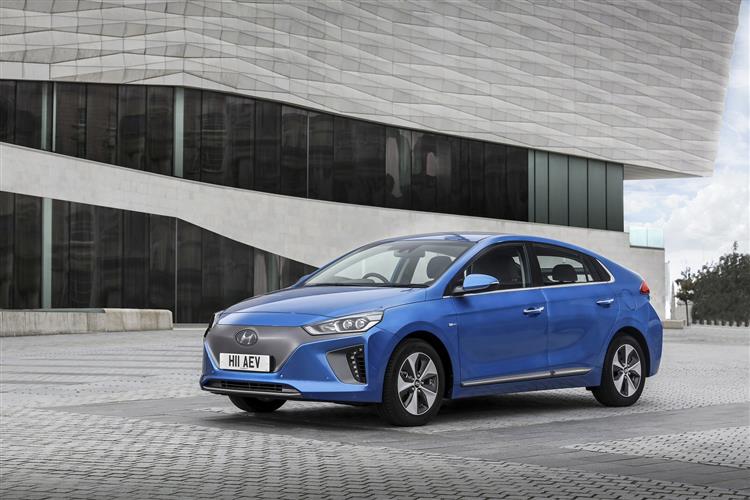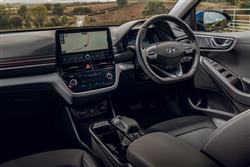AN IONIQ PERSPECTIVE (some text hidden) --NONE--
By Jonathan Crouch
Introductionword count: 89
Back at the end of the 21st century's second decade, Hyundai reckoned that this IONIQ model 'democratised' electrified eco technology for automotive buyers - and there's something in that. In one hit, it covered off the Hybrid, Plug-in and Full-Electric market segments, showing the engineers behind established contenders like Toyota's Prius and Nissan's LEAF just how much further they could have gone. Let's take a look at this model from a used car customer's perspective, with a focus on the self charging Hybrid version that most original buyers chose.
Modelsword count: 13
5dr family hatch (1.6 GDi Hybrid, 1.6 GDi Plug-in Hybrid / IONIQ Electric])
Historyword count: 299
Once upon a time, Hyundai built simple, cheap, budget brand cars. By 2016 though, it was making models like this one, the IONIQ, the world's first vehicle to offer the choice of three electrified powertrains. Back at the launch of this model - and even today - it's easy to get confused when trying to buy an ecologically-orientated car. Should you dip your toe in the water with a Prius-style petrol/electric hybrid? Or throw caution to the wind and choose a Nissan LEAF-style full-electric battery-powered model? Or maybe go for the kind of compromise you can find in the form of one of those Plug-in hybrids? Can't make up your mind? Evidently Hyundai couldn't either because it designed the IONIQ to be able to offer all three options and the result was a car that was fundamental in the company's plan to overtake Toyota and establish itself as the leading Far Eastern brand in Europe. To take on its key rival, the market-leading Toyota Prius, the IONIQ got a proper, modern lithium-ion battery, rather than the old fashioned nickel metal hydride unit used in the Prius. And a proper smooth-shifting auto gearbox too, rather than the jerky belt-driven CVT unit that back in 2016 all hybrids had previously used. That cost this car a little in terms of ultimate efficiency, but Hyundai believed buyers would see that to be a price worth paying in return for what was claimed to be a much more driveable product. The initial self charging Hybrid version was quickly followed by Plug-in Hybrid and full-Electric IONIQ variants. The range was lightly facelifted in 2019 and then sold in that form until late 2022, when it was phased out to leave more room for Hyundai's new range of full-electric IONIQ 5 and IONIQ 6 models.
What You Getword count: 346
This Hyundai challenged the eco-motoring status quo in lots of ways and exterior design was another of them. It's certainly very sleek, with a class-leading drag co-efficient of just 0.24Cd that embarrasses a rival Prius of the period, thanks to design touches like front wheel air curtains and a special aerodynamic floor panel that covers the underside of the car. Inside, you'll find a cabin intentionally bereft of obviously futuristic design. Presumably, the idea was to appease people put off by the nerdy vibe of a Prius or a LEAF and make the transition from an ordinary petrol or diesel-powered family hatch into one of these as painless as possible. A TFT instrument cluster is provided on all models and if you can avoid base 'SE' trim, it'll be 8-inches in size, with the display flanked at either side by an ECO driving meter on the left and a battery charge indicator on the right. As you'd expect in a modern family hatch, a touchscreen monitor assumes centre-dash prominence and provided you can avoid that base 'SE' trim level, it'll be supplied in a decently-shaped 8-inch size, complete with satellite navigation with life-long map updates, a high quality Infiniti DAB sound set-up, an integrated rear view camera and access to the 'Apple CarPlay' and 'Android Auto' smartphone-mirroring systems. And in the rear? Well normally, these seats would have been positioned a little lower to compensate for the swept-back ceiling, but that's not possible here since they sit right on top of the powertrain's battery pack. At least legroom's quite adequate, even for quite tall folk, and thanks to a low centre transmission tunnel, it should be possible to take three adults across the back seat in reasonable comfort, providing the journey in question isn't too long. And boot space? Well the IONIQ Hybrid model can deliver 443-litres of cargo capacity- or 550-litres if you stack your stuff up to the roof. Carriage capacity on IONIQ Electric variants falls to 350-litres - or 455-litres if you load to the roof. It's 341-litres with the Plug-in Hybrid version.
To see the full road test text contact us on 0330 0020 227
Pictures (high res disabled)

.jpg)
|
.jpg)
|
.jpg)
| |||
.jpg)
|
.jpg)
|

|
Scoring (subset of scores)
Category: Hybrid, Plug-in, Electric & Hydrogen
| Performance | |
| Handling | |
| Comfort | |
| Space | |
| Styling, Build, Value, Equipment, Depreciation, Handling, Insurance and Total scores are available with our full data feed. | |



